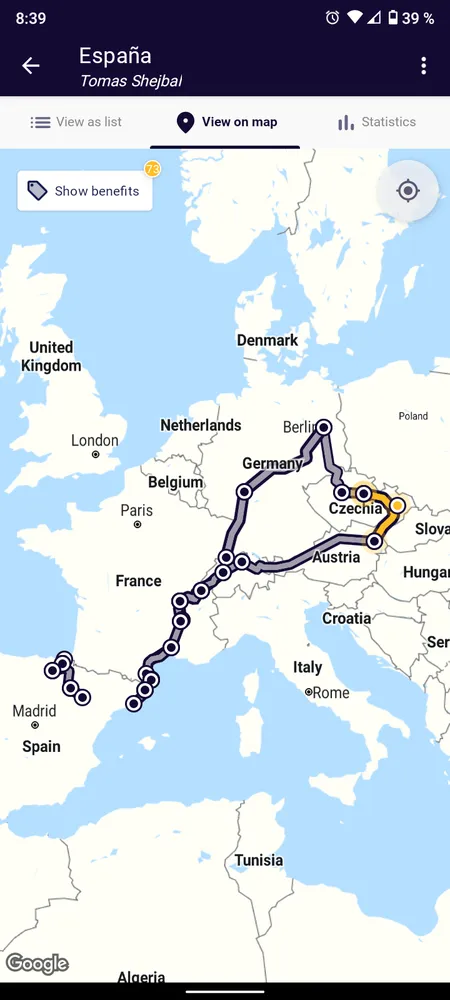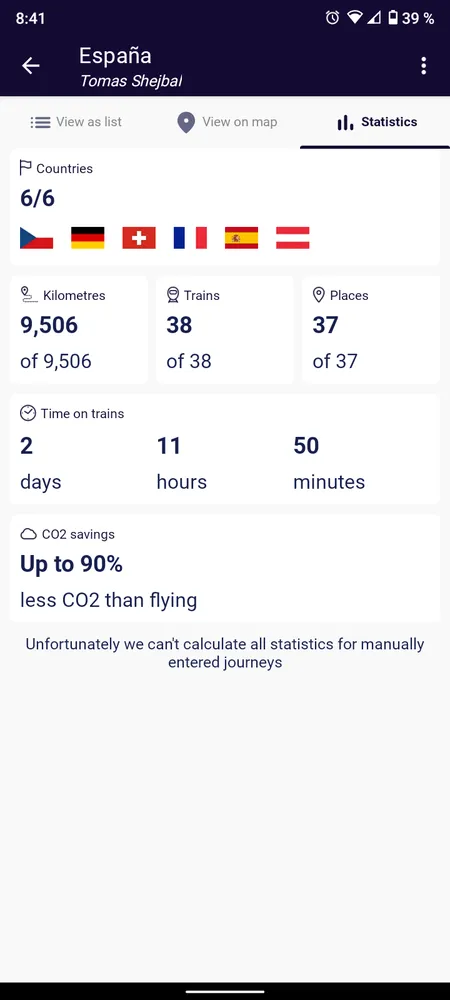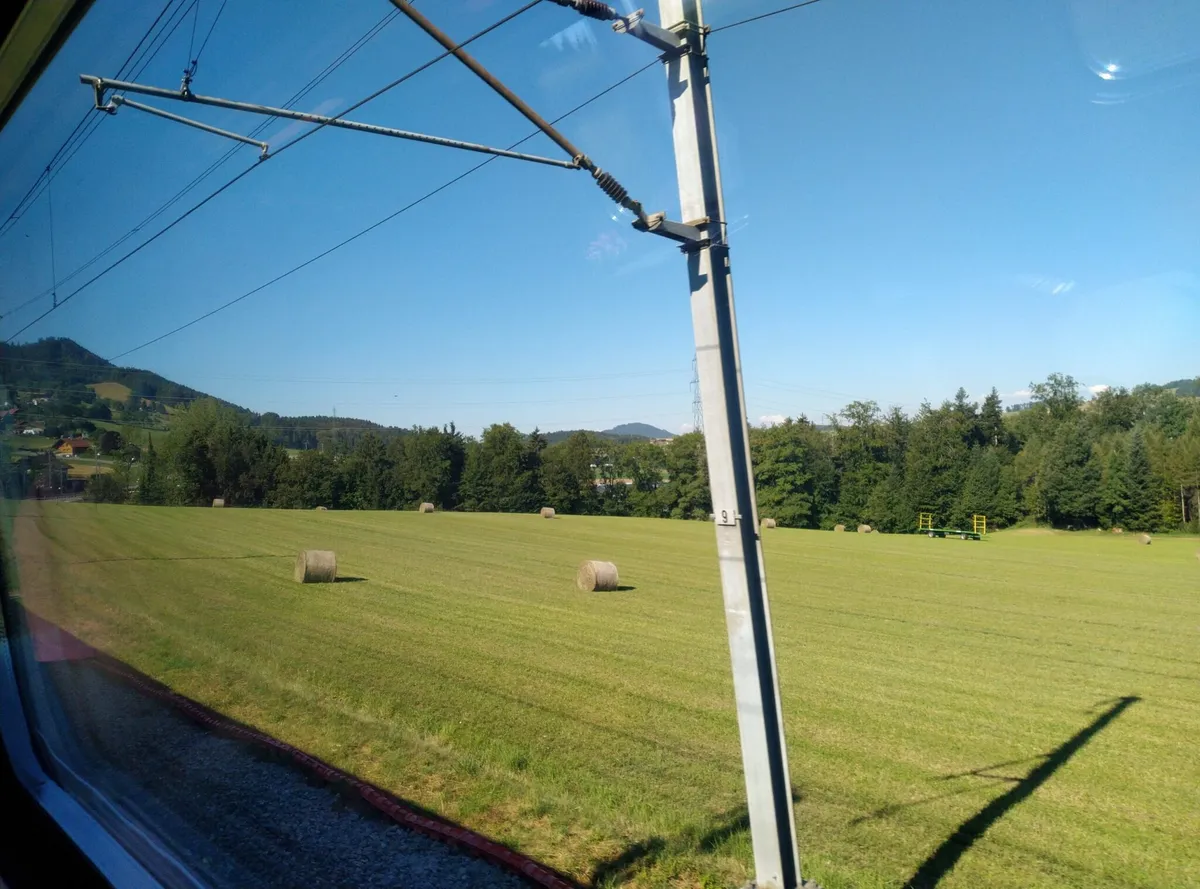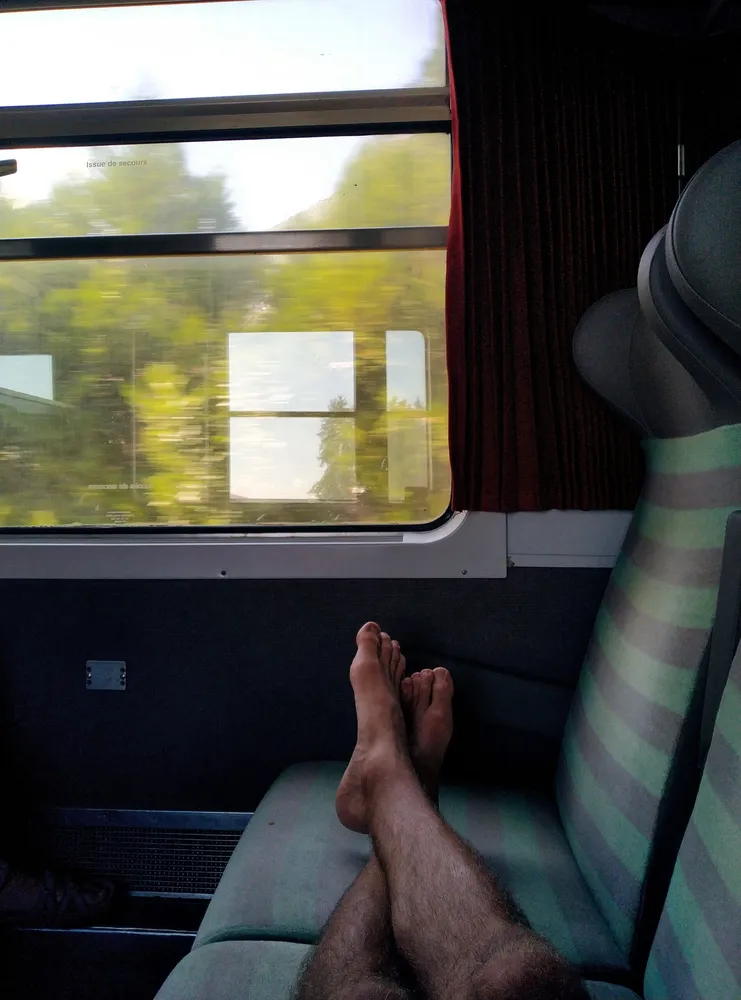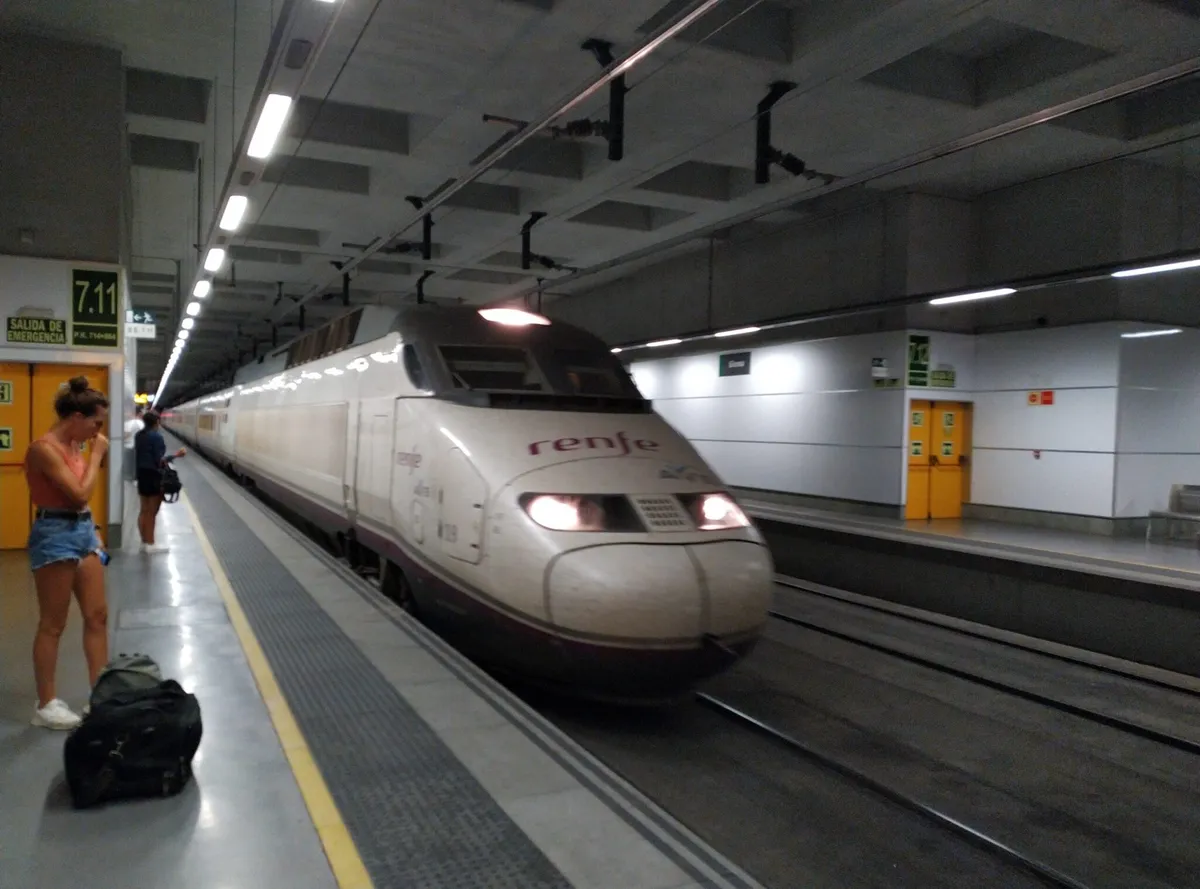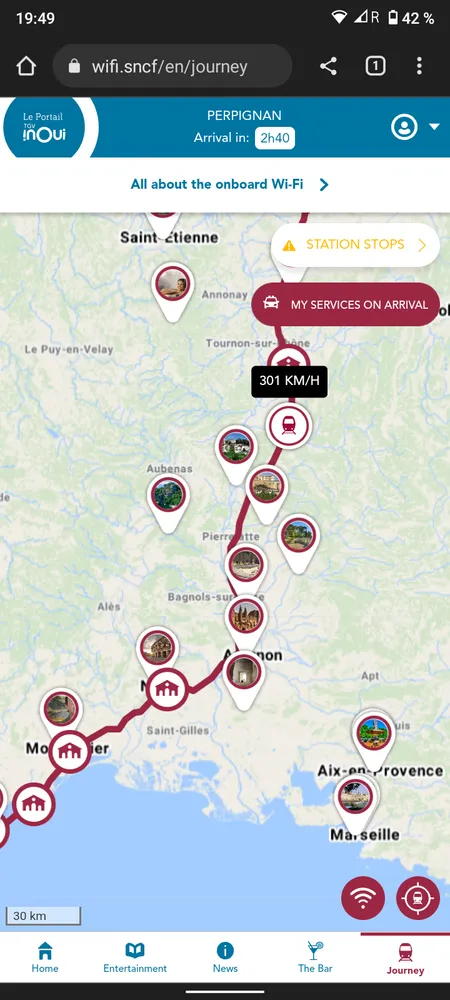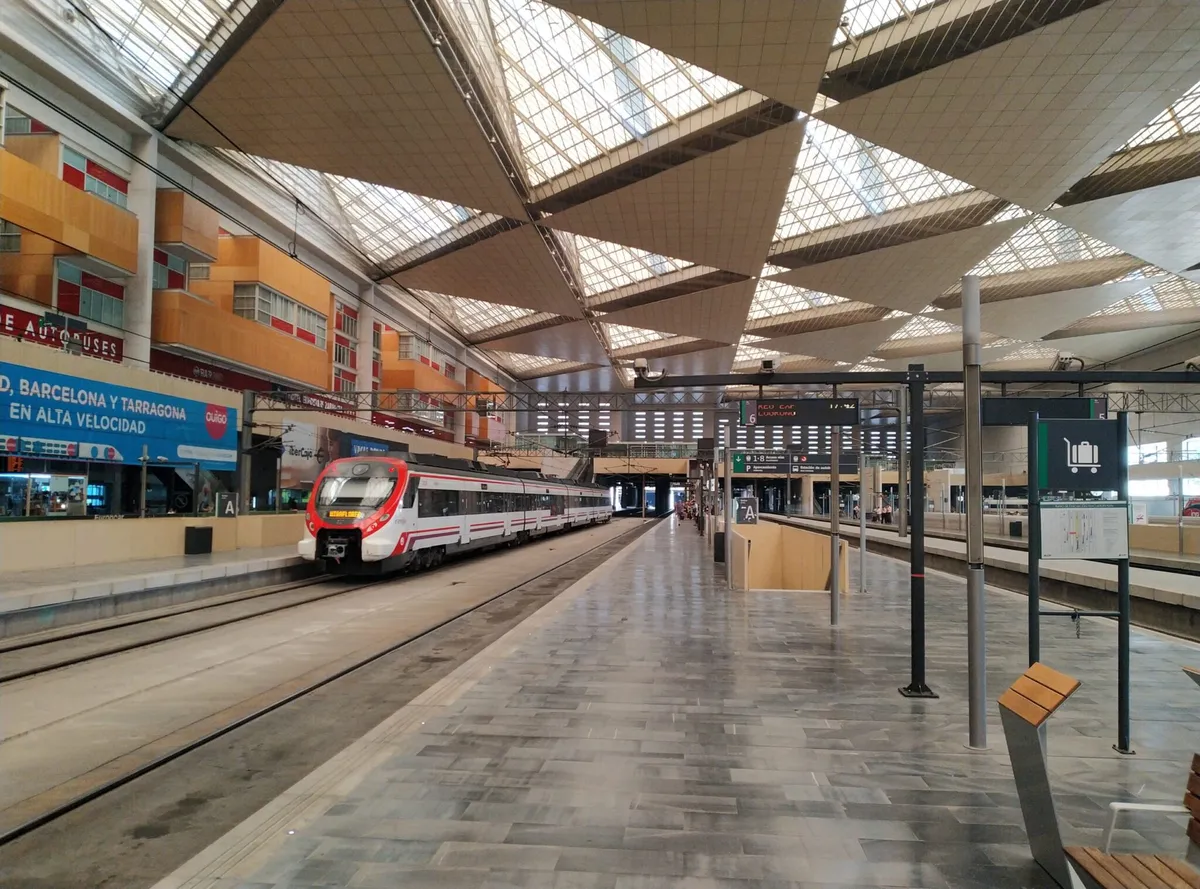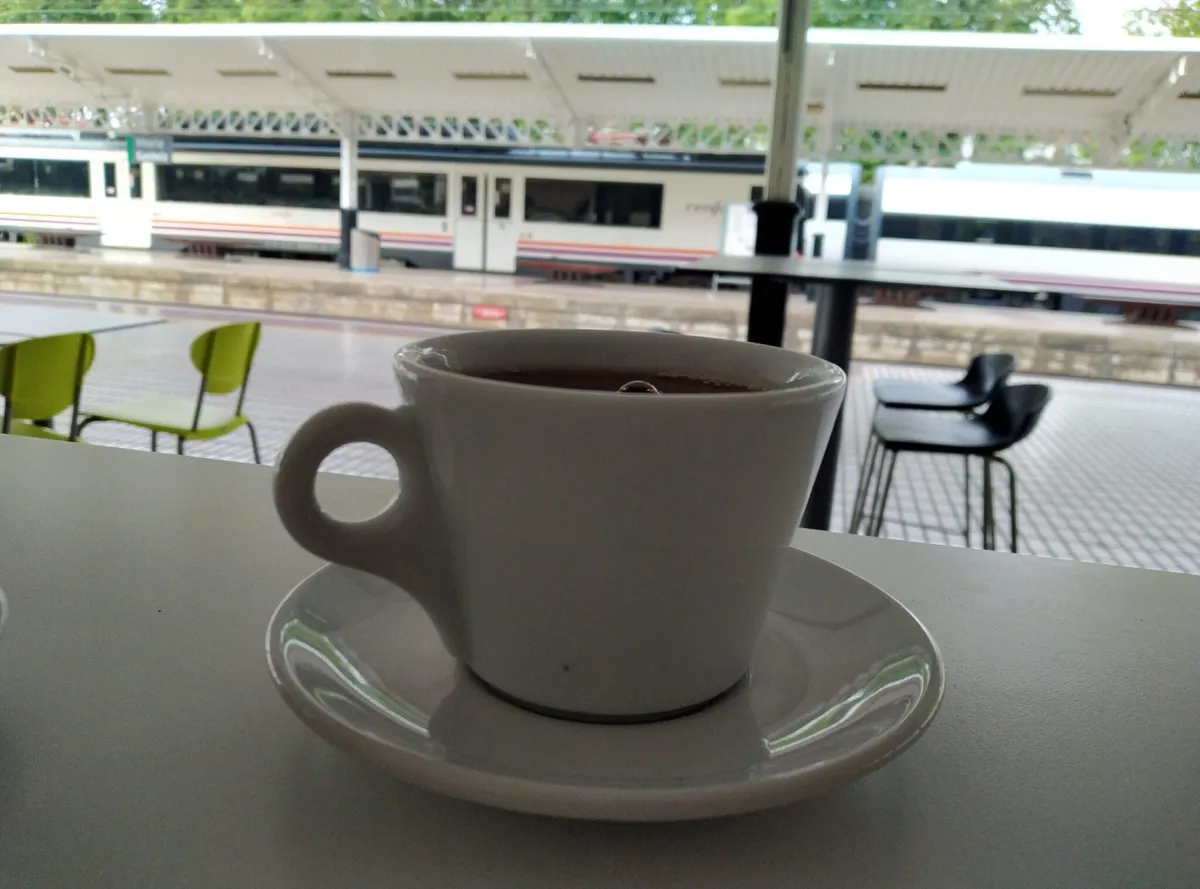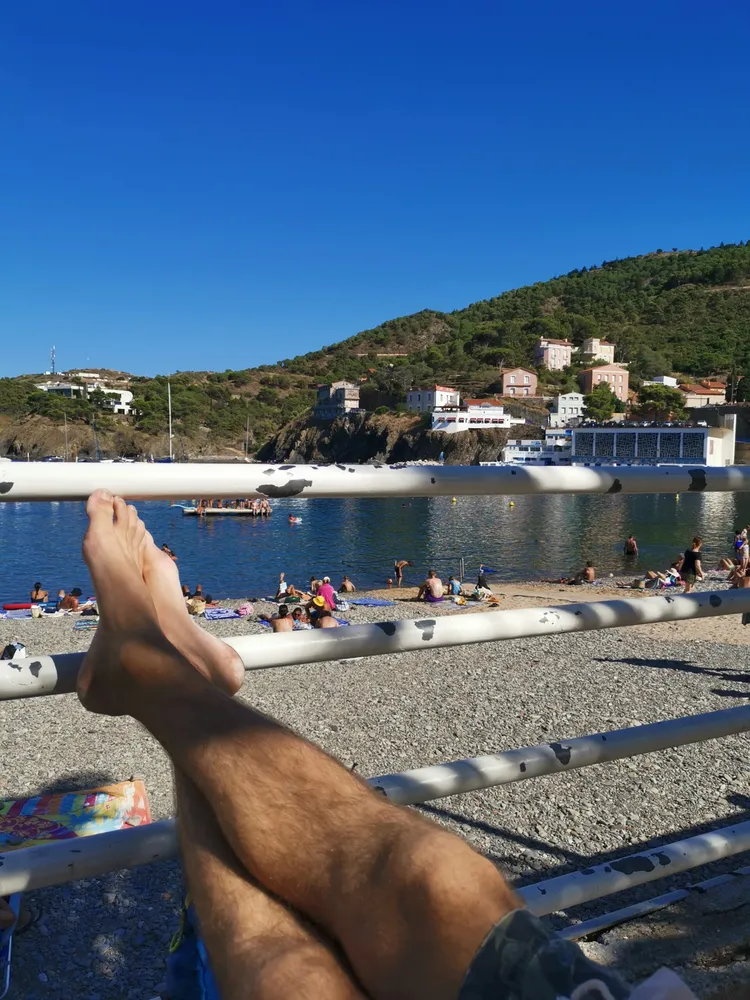How to get to Spain by train
For the last two years, a three-hour flight to Spain felt like sex with the intention of finishing as quickly as possible. So this August I went about it differently. We set off to Spain by train.
How to get from Pardubice to Spain by train? Is it worth it? How to search for connections, how... read on.
Or rather by train to southern Italy?
How did I come up with the idea to go to Spain by train?
I've been carrying the idea for such a trip in my head for two years. Sometime in May I came across a 50% discount on an open European ticket valid for one month. I took it as a sign.
I enjoy doing things differently and a train journey from Pardubice to Spain definitely falls into this category (yes, the scooter didn't cure me of similar "nonsense"). I wanted adventure. New experiences, slowing down. To experience that distance, not spend three hours looking at clouds. See how the landscape changes, travel through the Alps and Pyrenees, observe people. Verify whether trains in Switzerland really run so punctually - more on that later.
Reasons for traveling to Spain by train in bullet points
Besides the reasons mentioned above, also several others, and I'll continue criticizing buses and cars:
- I perceive trains as more free.
- Train stations are usually very close to city centers, longer transfer times can be used for quick city visits. That's not possible with flying.
- No need to be at the station too early. No security checks (except one for high-speed trains in Spain).
- While watching the landscape and listening to music, lots of ideas come to me. Suddenly I'm in some pleasantly dreamy state where many ideas come.
- Similarly at night, when I'm teetering on the edge between wakefulness and sleep (I have lots of notes - you have something to look forward to!).
- By car I'd have to drive and look ahead for 24 hours of driving, maybe occasionally glancing at grassy slopes where the highway is embedded. In cities I'd deal with parking and such...
- Buses are too tour-like, you can't move around in them, people are too close together.
- A bit of CO₂ savings. I don't know, but CO₂ from travel doesn't really bother me that much. "How so? You deal with ecology on your blog?" I hear questions. CO₂ and travel. That's a topic! I have it this way: on trips I learn and discover. Lots of ideas come to me, I rest. Then I can continue creating freshly. For example, thanks to a trip to India I gradually reduced meat to zero. Someone might shout about how much CO₂ that trip produced... is one flight more, or a permanent change? I'm for change! Feel free to write in the comments how you see it. Oh and I occasionally plant a tree or pay someone to do it for me.
Besides being more time-consuming, train travel also requires disproportionately more planning. If you're considering setting off somewhere by train, then in the next chapter you'll be purring with delight from the provided information (don't mention it!).
How to plan a train trip to Spain?
Generally
Getting to Spain by rail isn't completely simple. Especially when planning the trip a month in advance and traveling in August - probably the worst possible month for traveling around Europe (but mandated vacation mandates).
If I compare the trip to Girona with, say, Split (direct train - although Tomáš Hajzler doesn't have a very positive experience) or Rome (one transfer in Vienna, without my or anyone's experience), when traveling by high-speed trains you transfer at least 4 times and it takes about 24 hours.
High-speed trains go fast, but usually connect major cities that (unlike regional trains) don't follow an imaginary direct route. Therefore the time difference when using regional trains isn't that big (about 6 hours more), just the number of transfers increases (about 12 trains). However, the financial savings are significant, because high-speed trains in France and Spain have mandatory seat reservations and especially in August when planning a month in advance they're often booked. And a month in advance it's not even possible to make a reservation for a Spanish train - I'll get to that.
To Spain by train with the Interrail Rail Planner app
After purchasing a Global Pass from Interrail, it's good to download the Eurail/Interrail Rail Planner app, with which you can plan connections, find out if reservations are needed for given trains, and last but not least, prove to conductors with a QR code.
The QR code is one for the entire trip and below it only departure and arrival stations appear (according to current time). So the conductor only sees whether the Global Pass is valid after scanning the QR code. Some conductors also looked to see if we had the connection listed in the app.
Note: In areas with slow data, the app loads the QR code "infinitely" long. However, if the phone switches to airplane mode, then the QR code displays immediately.
The app is good for finding connections on trips, but for planning a trip it's better to use a browser and the ability to have multiple open tabs next to each other. I don't recommend idos, you can easily get burned with it. If not idos, then what?
Searching for connections
Not only for planning a train trip to Spain, I recommend using the search engine of German railways. For Spanish trains it worked even better than the domestic Renfe. I also downloaded the DB Navigator app, which I used during the trip.
In the German search engine you can turn off high-speed trains, set minimum times between transfers and much more. You can thus quite comfortably plan the entire trip from one place. The biggest problem is however in reservations. These can be excluded, which however stretches the journey. The result was therefore a compromise between time and the price of reservations.
To Spain by train without idos! At first I used our idos for searching, which works well for us. After entering Pardubice - Barcelona, it did find a connection, but for one train in Austria it listed the arrival time two hours earlier than reality. Thus idos planned connecting trains regardless of the fact that the train had an actual arrival after the departure of the connection😀
Reservations
Here I got burned right at the start. I found a night train from Vienna to Munich, reserved two seats through Interrail (there's a 4€ fee per reservation - couldn't make a reservation through ČD, same with OBB) and planned further. Subsequently I found out that the next day we couldn't move through France without a reservation.
The reservation was naturally non-refundable. So I proceeded in reverse and completely abandoned the route through Paris that I originally planned. Instead I chose the route through Switzerland, which is definitely more economical regarding reservations and you don't need to fear transfers in Switzerland. Plus the views from the windows are breathtaking.
Because I left all the planning until July, it wasn't possible to make a reservation for the Lyon-Barcelona high-speed train. That's quite crucial, because with regional trains (which we ended up taking), the journey stretches and there's also a need to sleep somewhere along the way.
The mentioned high-speed train was operated by Spanish Renfe - which is absolutely crucial! The Spanish namely don't support online reservations. This can still be circumvented through Interrail, but the Spanish insist on sending physical proof of reservation by post. For this reason they force travelers to reserve seats at least 6 weeks before train departure!
How did we actually go to Spain by train?
Journey to Spain
The itinerary for the train trip to Spain (July 29, 2022) looked as follows:
| from | departure time | to | arrival time | journey length (according to timetable) | reservation cost (per person) |
|---|---|---|---|---|---|
| Pardubice | 14:09 | Prague | 15:22 | 1:13 | 35 CZK (optional) |
| Prague | 16:25 | Berlin Suedkreuz | 20:35 | 4:10 | 75 CZK (optional) |
| Berlin Suedkreuz | 21:35 | Frankfurt (Main) Hbf | 02:11 | 4:36 | 75 CZK (optional) |
| Frankfurt (Main) Hbf | 02:45 | Basel Sbb | 6:20 | 3:35 | - |
| Basel Sbb | 06:25 | Bern | 7:26 | 1:01 | - |
| Bern | 7:34 | Geneva | 9:18 | 1:44 | - |
| Geneva | 11:30 | Lyon Part Dieu | 13:24 | 1:54 | - |
| Lyon Part Dieu | 15:20 | Valence Ville | 16:32 | 1:12 | - |
| Valence Ville | 18:13 | Valence Tgv Rhone-Alpes Sud | 18:20 | 0:07 | - |
| Valence Tgv Rhone-Alpes Sud | 19:27 | Nimes | 20:11 | 0:44 | 10 €(mandatory); airbnb in Nimes |
| Nimes | 12:14 | Port-Bou | 15:45 | 3:31 | - |
The last row shows the connection we were supposed to take to Spanish Port-Bou (on Sunday July 31, 2022). However, it ended in Perpignan. Why, you'll find out in the next chapter. Because of this, the continuation of the journey looked like this:
| Nimes | 12:14 | Perpignan | 14:48 | - | |
|---|---|---|---|---|---|
| Perpignan | 15:55 | Cerbere | 16:31 | 0:36 | - |
| Cerbere | 18:04 | Port-Bou | 18:08 | 0:08 | - |
| Port-Bou | 18:39 | Girona | 19:42 | 1:03 | - |
Journey back to Czech Republic
The journey back was much smoother, because we made seat reservations at the counter a few days after arrival for AVE (high-speed train) Girona-Lyon (remember how I said it can't be done online?) and thus avoided several regional trains in France.
The itinerary for the train journey to Czech Republic (August 25, 2022) looked like this:
| from | departure time | to | arrival time | journey length (according to timetable) | reservation cost (per person) |
|---|---|---|---|---|---|
| Girona | 8:56 | Lyon Part Dieu | 13:22 | 4:26 | 27 € (mandatory, but first class, because there was no space left in 2nd) |
| Lyon Part Dieu | 14:38 | Geneva | 16:35 | 1:57 | - |
| Geneva | 16:42 | Zurich Hb | 19:28 | 2:46 | - |
| Zurich Hb | 21:40 | Wien Hbf | 6:34 | 8:54 | 12 EU (mandatory) |
| Wien Hbf | 8:10 | Hranice na Moravě | 10:30 | 2:20 | 75 CZK (optional) |
| Hranice na Moravě | 11:31 | Pardubice | 13:43 | 2:12 | 75 CZK (optional) |
How to move around Spain by train?
Interrail works on all connections from Renfe and also Renfe Cercanías, which are suburban trains. In Catalonia, Cercanías are called Rodalies, but it's the same thing. I installed the Renfe app, but didn't use it for anything. However, I used the Renfe Cercanias and Rodalies de Catalunya apps extensively - you can search train connections in them that other search engines can't reach.
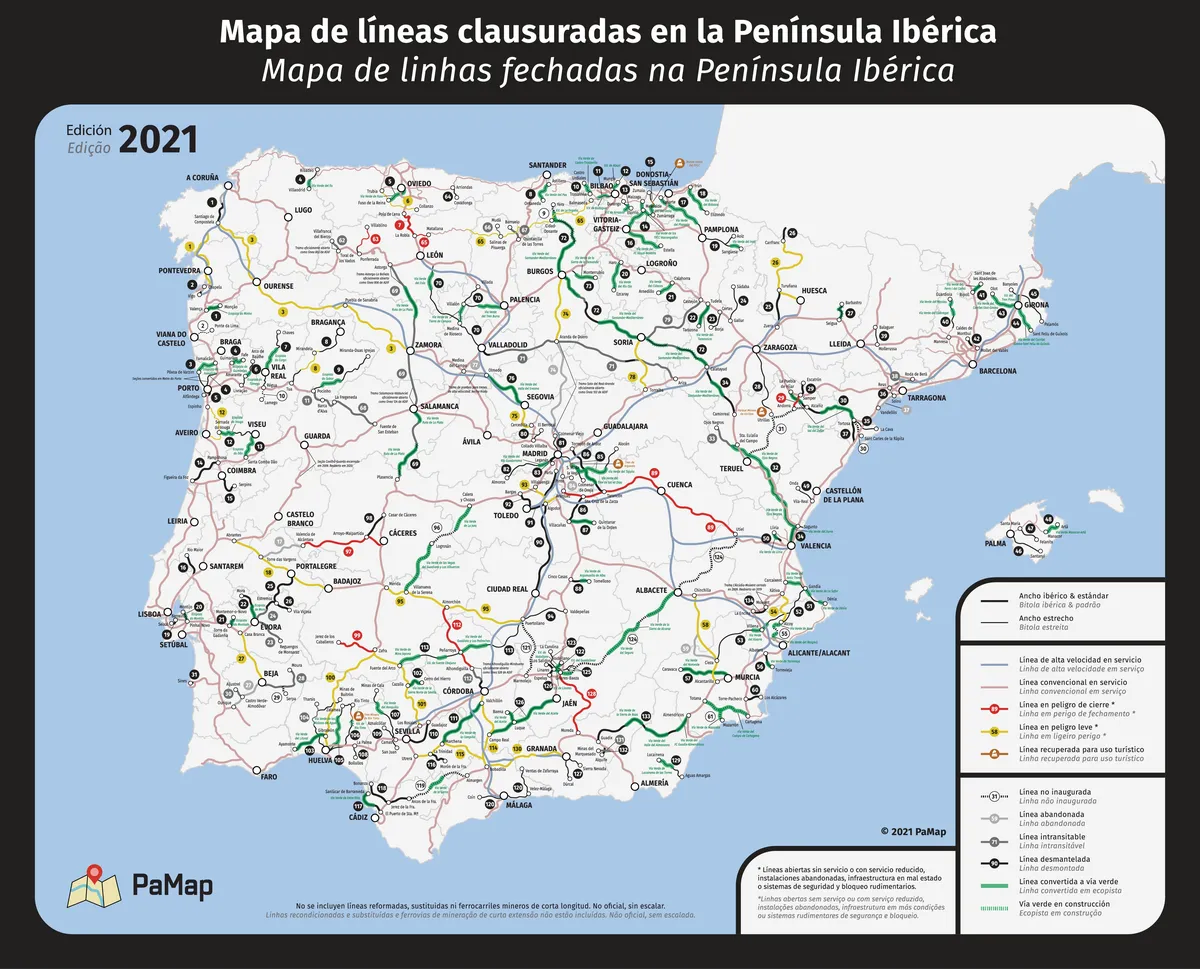
With Cercanías we encountered a problem when using Interrail: most turnstiles only read tickets with magnetic strips. QR codes were only read by turnstiles at Barcelona-Sans station. So we had to contact staff/security every time. They either pressed some magic button and the turnstile opened, or gave us a ticket with a magnetic strip that the turnstile ate and let us through. Several times we called information and someone opened the turnstile remotely. But once it happened that no one opened it for us.
Basque Country - euskotren
In the Basque Country, Renfe operates, but only between Vitoria and Bilbao and also between Vitoria and San Sebastian. There are however other tracks - between San Sebastian and Bilbao, where suburban euskotren trains operate, but Interrail doesn't work on them. You need to get a Barik card, which is also valid for metro in Bilbao and generally public transport in Bilbao and San Sebastian. The Barik card costs 3€, but pays for itself in two or three rides. Moreover, multiple people can travel on it simultaneously (just touch the turnstile as many times as people are traveling). You can top up via mobile phone with NFC.
What were the travel costs?
We bought the Interrail ticket with unlimited validity for 30 days in May, when it was sold with a 50% discount. Even so it came to 344€ (about 8500 CZK per person). With all reservations the monthly train travel thus came to 10500 CZK per person. Except for two bus transfers and traveling around Bilbao with the Barik card (+2000 CZK per person), Interrail covered all trips. Total for travel per person therefore 12500 CZK.
Honestly, I don't care if the trip was more expensive or cheaper than airplane or other forms of transport. I wanted to go by train, as I already wrote above 🙂
Cost comparison of train travel vs. airplane and car
However, for those who like numbers: last year we flew in August by plane from Pardubice to Alicante, from where we moved to Valencia and surrounding area. Just the ticket with a low-cost carrier (we flew only with carry-ons) was 6700 CZK. Just car rental for 7 days came to 10000 CZK. Then there were some train trips (together 1200 CZK). Last year's costs for travel thus came to 12300 CZK per person. Now we were traveling for 28 days, last year only 14, so half.
If we had gone by car, we would have driven about 4800 km (counting only transfers, not smaller trips at destinations) -> 48 (hundreds of km) x 7 (average consumption of our pet on the highway) x 45 (price per liter of gasoline), we get 15000 CZK for gasoline (however for both), without highway tolls, insurance, parking, etc.
Various variants (and thus prices) of Interrail tickets
The ticket price may thus at first glance seem excessive, but it depends on its further use in the destination and some planning, because Interrail offers various ticket variants (as of the date of writing the article), which are interesting even without 50% discount:
- 15-day ticket valid for a month for 332€ (7900 CZK) - that would almost suffice for us too - we traveled 17 days within one month.
- 7-day ticket valid for a month for 251€ (about 6200 CZK): then 4 days would fall on the journey there and back and 3 days on transfers around Spain. For closer destinations it could be used even better.
- 4-day ticket valid for a month for 185€ (about 4500 CZK): just transfer to Spain and back.
Good to mention
Watch out for Switzerland and long live mobile credit!
Well, I didn't read this SMS and in the blink of an eye lost 300 CZK of credit. Hooray, if I didn't have credit...!
Welcome to Switzerland. Calls to CR and EU cost 35.00 CZK/min, receiving calls 18.00 CZK/min, SMS 9.60 CZK, MMS 16.60 CZK. Internet connection costs 75.00 CZK/MB (we charge it per 10 kB). You have the Data roaming limit service enabled. For calls to CR use prefix +420, e.g. Customer center: +420738333333. Listed prices include VAT.
Toilets in Switzerland
In Switzerland you pay for physical needs and not little. Basel and Bern for 2 CHF (about 50 CZK). Zurich even 2.5 CHF. You can't pay by card. In Zurich however it's enough to go in front of the station, where there are public toilets for 1 CHF and you can pay by card. Locals even pass doors to each other.
Delays on journeys
There were delays, but the biggest problem was hitches in France - see below.
- Anyone who traveled by train in Czech Republic this year knows that delays of tens of minutes are daily bread.
- I was surprised that even in Germany - in the night train from Frankfurt to Basel we waited an hour (departing from Frankfurt), without anyone informing us why we were standing.
- In France 20-minute delays were not uncommon.
- But in legendary Switzerland we had the biggest delay of 3 minutes and only once. Otherwise always on time and once the train even left a minute early.
- In Spain, where we spent the most time, delays were commonly up to 10 minutes.
Complications on French railways
Weekend July 30-31, 2022 there was a strike on French railways. Of course we didn't know. We only found out on the Nimes - Port-Bou train. Already on the platform it seemed strange that the train was only listed to Perpignan (the train number matched).
During the journey I googled and found that most high-speed trains on the route were cancelled and regional trains ended in Perpignan. Buses naturally fully booked, blablacar too. So what? Another accommodation in France? Veronika already felt Spain in the air (she reveres Spanish language and Spanish culture while resisting French) and was willing to do anything to not spend another night in France.
Perpignan -> Cerbere
I searched for options. I found a regional train that went along the coast to Cerbere - the last village before the first Spanish village (Port-Bou), about a kilometer as the crow flies. On mapy.cz there was even a marked tourist trail, about 3 km long, just with a hill between France and Spain. The hiking app estimated one hour. I didn't really want to, it was warm and mainly it was about principle! We wanted to arrive in Spain by train, from which we were separated by 1 km as the crow flies! But Veronika grabbed onto the possibility and no longer intended to give it up.
Cerbere -> Port-Bou
After arriving in Cerbere I just habitually looked at the departure board and found information that the Spanish side was sending an extraordinary train due to strikes, just for the Cerbere - Port-Bou connection. It was supposed to leave in an hour. Since Cerbere lies by the sea, such waiting can be endured quite well by us seasiders (see photo on the right). And the hour-long route over the hill shrank to 8 minutes by train, mostly through a tunnel.
I thus fulfilled my dream - I arrived in Spain by train! And thank you Veronika for not being scared of the railways and going into it with me!😋
What about setting off by train to Italy?
Twice-monthly curated nuggets about conscious living, sustainability, and the art of slowing down.
Written by someone who uses a bidet, composts religiously, and thinks bitcoin might save the world.


